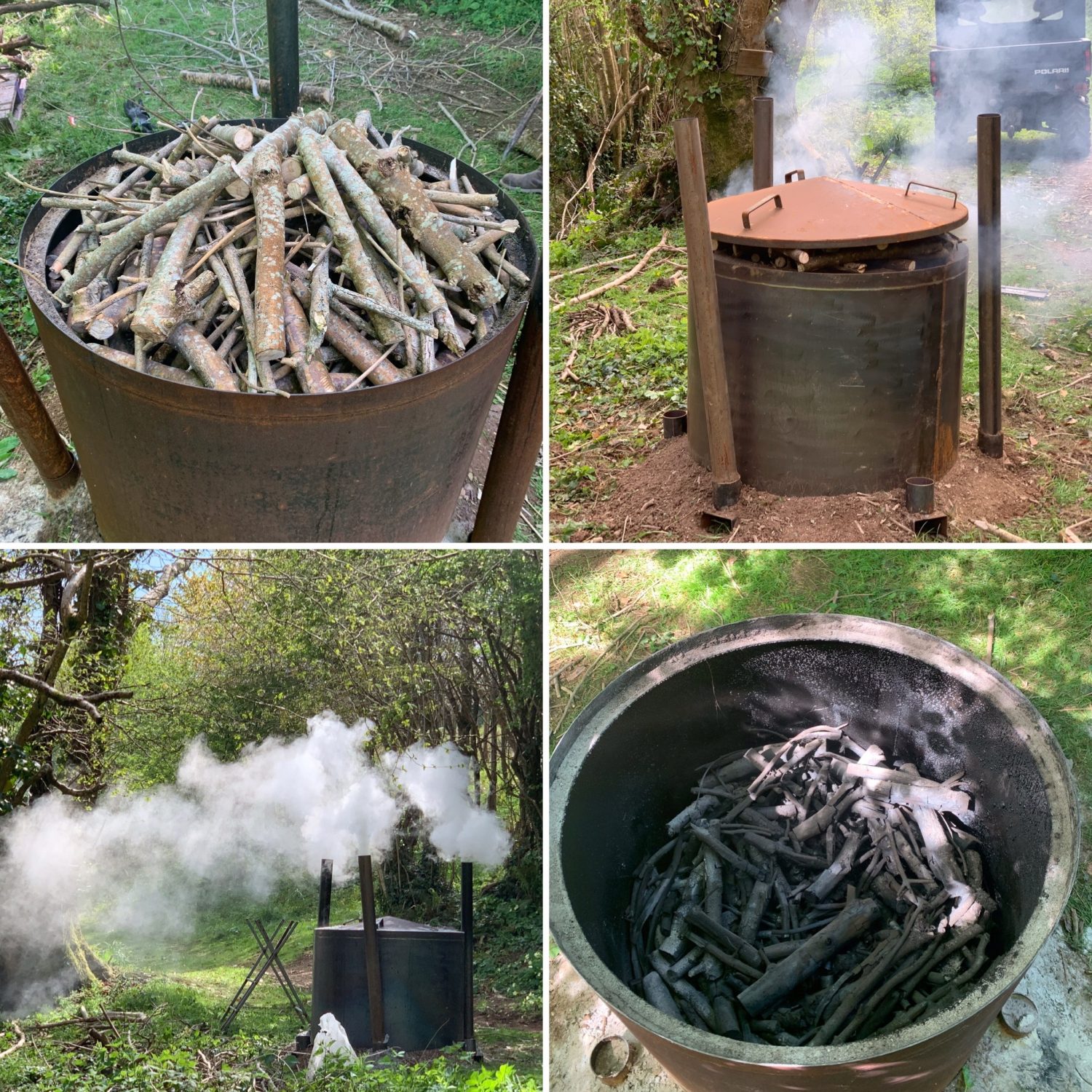
For this blog I thought I would show you our newest venture at the Sanctuary – charcoal making! David decided he wanted to have a go, using our left over ash. We have had to take some Ash down unfortunately due to Ash dieback, and although we saved the larger pieces for drying to use in our wood boiler and wood stove, that still means lots of bits. Some of it we scatter to provide habitats for beetles etc, but that still leaves loads to deal with. So enter the Charcoal kiln – it was made to order, so after about 6 weeks it was ready to try out…..David had read lots on the subject and watched videos, but there is nothing like doing it yourself to find out the dos and don’ts! Our friend – another David couldn’t resist coming over to see for himself and soon got roped into helping!
- We sited the kiln at the edge of one of the woods, very near to where we had felled some Ash. It’s also quite tricky to find flat enough pieces of land to place it too…..
- The kiln is then very carefully filled with wood, trying to make sure there are as few gaps as possible, but leaving a space in the middle for the kindling..
- It is also piled up above the top of the rim, to allow for it to sink whilst burning and keep the kiln as full as possible…
- The kiln is lit, and it has 6 x vents that poke out from the base, and 3 chimneys. As the wood starts its burn, these chimneys are moved around the vents to make sure everything is burning evenly.
- Gradually, the wood starts to sink, lowering the lid, and after about 4 – 6 hours the smoke changes from white to a grey blue, and that is the signal to take off the chimneys, and block up the vents and seal the lid with mud, turf or sand – anything that will keep the oxygen out.
- Then the worst bit – waiting! You have to leave the kiln for 24hrs to cool down – opening it too soon may add oxygen and cause the whole thing to relight, so this is crucial!
- Only after it has cooled can it be opened to discover whether you have beautiful pieces of charcoal or ash! Although, we have since discovered that when we riddle it to select the larger pieces, the tiny bits are now bio char which is very good as a soil conditioner, so sticking to our ethos, nothing is wasted!
- We then bag it up and so far have given some to friends and mainly used it in our fire pits for cooking, or in our pizza oven, but we would like to offer it for sale in the village and locally, especially if it can be carried by foot or wheelbarrow to wherever it is needed!
Down at our local,The Fisherman’s Arms, there ensued a discussion about the environmental impact of charcoal burning – didn’t it release CO2? And therefore was it actually causing damage to the environment?
So, a bit of research was needed, and as always, open to interpretation, this is what I found out….
- CO2 – when wood is burned it releases the CO2 it has absorbed during its lifetime. By planting new trees more CO2 is absorbed, although it must be pointed out that a tree will need to mature before it capable of a decent rate of absorption (that’s why planting millions of 12 inch twigs and claiming carbon neutrality really doesn’t work…)
- Burning wood is less damaging than fossil fuels from a CO2 perspective. Some of the main CO2 problems is the fuels used to transport the charcoal, so the nearer it it is used to it production, the better.
- Coppicing is a vital and much neglected craft of ensuring the continuous health of a wood. Not all dead wood is bad – it creates homes for fungi, invertebrates – on the ground it can provide shelter for small animals, but to create light for trees to thrive, lessen the transmission of diseases, encourage young, strong and healthy growth, decent pruning is essential.
- When we burn charcoal it burns hotter and longer, so is very economical in its use, and creates much less smoke.
- According to an article in the Guardian, we as a country could be providing 100% of our own charcoal, yet we only produce around 3%. This means that by importing charcoal we are using vast quantities of fossil fuel to transport it (ours is transported by foot or wheelbarrow from the kiln to the fire pit!), and fuelling (pardon the pun) an industry that is in turn cutting down vast swathes of international forests to provide it, rather than a balanced, local production using what is in essence ‘offcuts’.
- Much of the stuff we buy in supermarkets and garages is not true charcoal – it is pulverised, baked and mixed with lighter fuel and such substances, which is why you can always sniff a petrol smell when starting out….and don’t get me started on disposable barbecues……
- Wood charcoal is lighter and easier to transport if you are going on a picnic….
- On the Fowey Estuary and many others, you will see the remains of limekilns……in order to create the heat that was needed to bake and release the lime from the limestone, charcoal was used, so even around here it was an important part of the life of the estuary…
Sources….. Dorset Charcoal www.dorsetcharcoal.co.uk. The guardian article https://www.theguardian.com/environment/2009/jul/02/charcoal-barbecues

